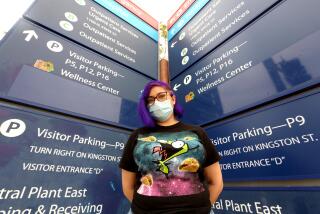Severe overcrowding is routine at L.A. County-USC Medical Center
- Share via
Even before the doors opened on the $1.02-billion Los Angeles County-USC Medical Center many observers warned that the new hospital was too small. Now, more than a year and a half of experience appears to confirm it.
The overcrowding has become so intense that health officials asked county Supervisor Gloria Molina eight months ago what she would think if the hospital began placing patients in the hallways, the supervisor recalled in an interview.
“I said, ‘Absolutely not. We will not have patients in the hallway,’ ” Molina said.
Instead, County- USC officials have increased patient transfers to other hospitals. Despite more than 2,000 such transfers since the November 2008 move into a building with 224 fewer beds, chronic, severe overcrowding is routine at the county’s flagship public hospital. Few long-term options to relieve the burden are available.
Last month, the hospital’s emergency room was overcrowded about 80% of the time, with conditions considered severe or dangerous for half of the month, according to the county’s own standards.
The decision to build the new County-USC at 600 beds was made by the Board of Supervisors in 1997, three years after the 6.7-magnitude Northridge earthquake damaged the old, cavernous Depression-era facility, located just northeast of downtown in Boyle Heights
.
Along with Molina, health department officials, physician and hospital trade groups and independent consultants all urged that the new hospital be built to hold 750 beds. Advocates said that capacity was needed to allow the county to provide life-saving care to anyone unable to afford it, as required by California law.
“If we undersize it, there’s great human damage,” Mark Finucane, then the county’s health director, said at the time.
“Where are people going to go?” asked Dr. Ronald Kaufman, County-USC’s chief of staff in 1997.
Molina, whose district includes County-USC, provided the only vote against the smaller hospital. The decision came two years after a massive health department deficit threatened to pull the entire county government into bankruptcy, saved only by a last-minute federal bailout.
The four other supervisors — Michael Antonovich, Yvonne B. Burke, Don Knabe and Zev Yaroslavsky — bet that better technology and more efficient management could make up for the reduction in size.
The decision was partially based on politics, which included the board majority’s distaste for Molina’s hardball tactics and anxiety over whether a larger hospital would be affordable, The Times reported at the time.
“The majority characterized their vote as a visionary nod to a future of improved technology and managed care that would continue to make hospital stays rarer and shorter,” The Times reported after the final vote.
But thirteen years later, the average stay at County-USC remains 5 1/2 days and the hospital is often packed to near capacity: In May, an average of 595 out of 600 beds were filled each day at midnight.
The result has been a bottleneck predicted by critics of the smaller facility: There are not enough beds to admit patients, causing back-ups in the emergency and waiting rooms.
“We’re seeing sicker patients.... Sicker patients take longer to diagnose and treat,” said Carol Meyer, chief network officer for the county Department of Health Services, which runs County-USC.
Increasing the emergency room staff would not solve the larger problem, said John Schunhoff, interim director of the health department.
“It’s also a matter of capacity of the size of the facility,” he said.
Since November 2008, County-USC has transferred 2,576 patients to Rancho Los Amigos National Rehabilitation Center in Downey, a 395-bed county hospital that is a 14-mile drive away, and to nearby private hospitals — an average of 136 transfers a month. In May, 170 patients were transferred.
The reliance on Rancho to handle overflow from County-USC has eliminated any hope that the Downey facility could be turned over to a private company, a move that would have saved the county an estimated $24.2 million annually.
The county must also finance the healthcare of indigent patients it transfers to private hospitals. Recently, county officials reached an agreement to pay Silver Lake Medical Center no more than $2 million a year to care for indigent uninsured patients.
County health officials cannot say whether transferring out indigent patients costs the county more than if it had built a 750-bed hospital. Schunhoff said the county has hired a consultant to determine whether the county’s hospitals are at an appropriate size.
Molina said she believes the only long-term solution is to expand County-USC. But she said, “I don’t think we would have the money.”
The health department faces a nearly $600-million deficit unless it can secure more federal funding. It is still working to reopen an emergency room and inpatient services in Willowbrook, at the site of the former Martin Luther King Jr.-Harbor Hospital.
Tony Bell, a spokesman for Antonovich, declined to comment on Molina’s assertion that County-USC was built too small.
“As far as we’re concerned … overcrowding is a problem faced by all of our county public hospitals,” Bell said. “The department’s focus should be on improving efficiency and patient flow.”
Bell also attributed the overcrowding problems to “a large illegal immigrant population” that uses the emergency room as a primary care facility.
More to Read
Sign up for Essential California
The most important California stories and recommendations in your inbox every morning.
You may occasionally receive promotional content from the Los Angeles Times.











